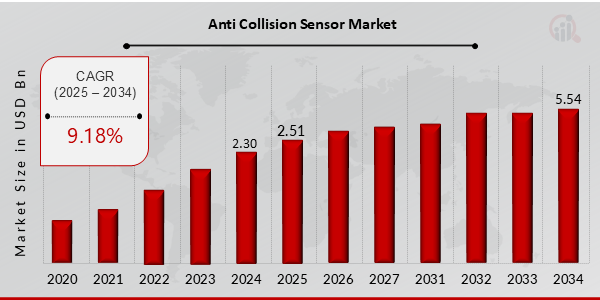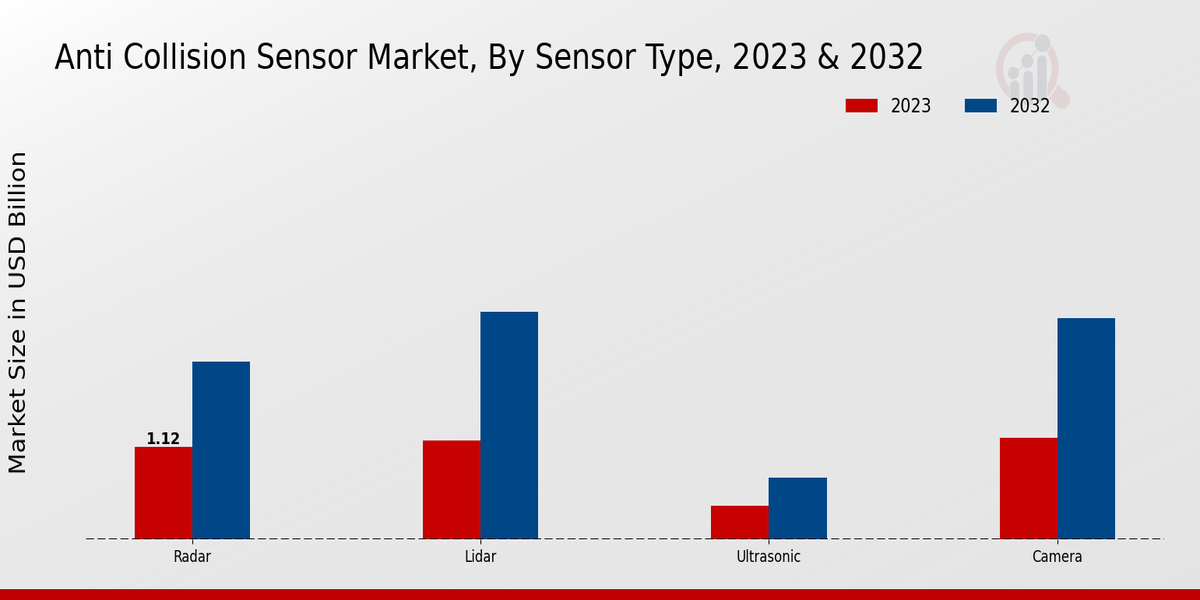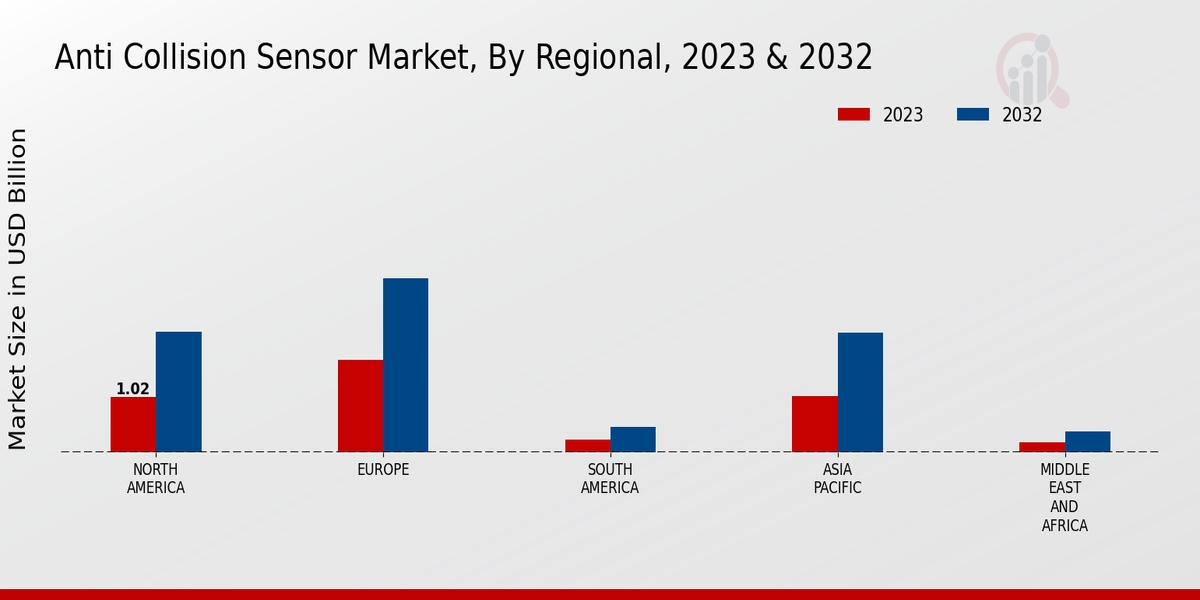Global Anti-collision Sensor Market Overview:
Anti Collision Sensor Market Size was estimated at 2.30 (USD Billion) in 2024. The Anti Collision Sensor Market Industry is expected to grow from 2.51 (USD Billion) in 2025 to 5.54 (USD Billion) till 2034, exhibiting a compound annual growth rate (CAGR) of 9.18% during the forecast period (2025 - 2034)
Key Anti-collision Sensor Market Trends Highlighted
Key market drivers for anti-collision sensors include the increasing demand for autonomous vehicles and advanced driver assistance systems (ADAS). Government regulations mandating the inclusion of anti-collision systems in new vehicles are also driving market growth.
Opportunities for exploration in the anti-collision sensor market lie in the development of more advanced sensor technologies, such as radar, lidar, and camera fusion. Additionally, the integration of anti-collision sensors with other vehicle systems, such as navigation and vehicle-to-vehicle communication, presents opportunities for innovation.
Recent trends in the anti-collision sensor market include the adoption of radar-based sensors due to their long range and ability to detect objects in all weather conditions. Lidar sensors are also gaining traction due to their high resolution and accuracy. Camera-based sensors remain popular due to their cost-effectiveness and ability to provide visual information.

Source: Primary Research, Secondary Research, MRFR Database and Analyst Review
Anti-collision Sensor Market Drivers
Rapidly Increasing Adoption of Advanced Driver Assistance Systems (ADAS) in Vehicles
The automotive industry is witnessing a surge in the adoption of Advanced Driver Assistance Systems (ADAS) as automakers strive to enhance vehicle safety and convenience. ADAS encompasses a range of technologies, including anti-collision sensors, which play a critical role in preventing collisions and mitigating their severity.
As ADAS adoption becomes more widespread, the demand for anti-collision sensors is expected to escalate significantly. This trend is being driven by growing consumer awareness of safety features, stringent government regulations mandating ADAS integration, and the increasing affordability of these technologies. The rising adoption of ADAS in both passenger cars and commercial vehicles is expected to drive the growth of the Global Anti-Collision Sensor Market over the forecast period.
Growing Adoption of Autonomous Vehicles
The advent of autonomous vehicles has further fueled the demand for anti-collision sensors. Autonomous vehicles rely on a suite of sensors, including anti-collision sensors, to navigate their surroundings safely and respond to potential hazards.
As the technology for autonomous vehicles continues to mature and regulations evolve to support their deployment, the demand for anti-collision sensors is anticipated to grow exponentially. This market segment represents a significant opportunity for manufacturers and suppliers of anti-collision sensors.
Government Regulations and Safety Mandates
Government regulations and safety mandates are another key driver of the global anti-collision sensor market. In many countries, governments are implementing stringent regulations that require the integration of anti-collision sensors in new vehicles.
These regulations aim to reduce the number of road accidents and fatalities by ensuring that vehicles are equipped with advanced safety features. As governments continue to prioritize road safety, the demand for anti-collision sensors is expected to increase substantially.
Anti-collision Sensor Market Segment Insights:
Anti-collision Sensor Market Sensor Type Insights
The global anti-collision sensor market is segmented by sensor type into radar, lidar, ultrasonic, and camera. Among these, the radar segment is expected to hold the largest market share of around 40% by 2024, owing to its high accuracy and long-range detection capabilities. Radar sensors use radio waves to detect and track objects, offering high accuracy and long-range detection capabilities.
The lidar segment is expected to witness the fastest growth over the forecast period, due to its ability to provide real-time 3D mapping and object recognition. They are widely used in automotive applications, such as adaptive cruise control, blind spot detection, and lane departure warning systems. Lidar sensors use laser beams to create a detailed 3D map of the surroundings, providing real-time object recognition and tracking capabilities. They are gaining traction in autonomous vehicles and advanced driver assistance systems (ADAS).
Ultrasonic sensors emit high-frequency sound waves to detect and measure distances to objects. They are commonly used in parking assist systems, rear cross-traffic alert systems, and object detection systems. Camera sensors use image recognition algorithms to detect and classify objects. They are widely used in lane departure warning systems, traffic sign recognition systems, and pedestrian detection systems.

Source: Primary Research, Secondary Research, MRFR Database and Analyst Review
Anti-collision Sensor Market Application Insights
The global anti-collision sensor market segmentation by application can be divided into automotive, industrial, aerospace and defense, and others. The automotive segment is expected to hold the largest market share in 2023, accounting for around 60% of the global revenue. The growth of this segment is attributed to the increasing demand for anti-collision systems in vehicles to enhance safety and prevent accidents.
The industrial segment is also expected to witness significant growth, owing to the rising adoption of anti-collision sensors in industrial automation and robotics to improve safety and efficiency. The aerospace and defense segment is expected to have a steady growth, driven by the increasing demand for anti-collision systems in aircraft and military vehicles to enhance situational awareness and prevent collisions. The others segment, which includes applications such as marine and rail transportation, is also expected to contribute to the overall market growth.
Anti-collision Sensor Market Vehicle Type Insights
The global anti-collision sensor market is segmented by vehicle type into passenger cars, commercial vehicles, and others. Passenger cars hold the largest market share due to the increasing production and sales of passenger cars globally.
In 2023, the passenger cars segment accounted for approximately 65% of the market revenue. The growing demand for advanced safety features and government regulations mandating the installation of anti-collision systems in new vehicles are driving the growth of this segment.
Commercial vehicles are also witnessing significant growth in the market. The increasing adoption of anti-collision systems in commercial vehicles, such as trucks and buses, to prevent accidents and improve fleet safety, is contributing to the growth of this segment.
The others segment includes specialty vehicles, such as military vehicles and off-road vehicles. The growing demand for anti-collision systems in these vehicles to enhance safety and situational awareness is driving the growth of this segment.
Anti-collision Sensor Market Regional Insights
North America is expected to hold the largest market share, followed by Europe, APAC, South America, and MEA. The growth in the North American market is attributed to the increasing adoption of advanced driver assistance systems (ADAS) in vehicles.
Europe is also expected to witness significant growth due to the stringent safety regulations and the growing demand for semi-autonomous and autonomous vehicles. APAC is expected to be the fastest-growing region due to the rapidly expanding automotive industry and the increasing disposable income of consumers. South America and MEA are also expected to witness steady growth in the coming years.

Source: Primary Research, Secondary Research, MRFR Database and Analyst Review
Anti-collision Sensor Market Key Players and Competitive Insights:
Major players in the anti-collision sensor market are continuously striving to develop innovative solutions to meet the evolving demands of customers. They are focusing on research and development activities to enhance the performance and features of their products. Leading Anti-collision Sensor Market players are adopting various strategies, such as product launches, partnerships, and acquisitions, to expand their market share and strengthen their position in the industry. The competitive landscape is expected to remain dynamic as new players enter the market and existing players expand their product portfolios.Continental AG is a leading Anti-collision sensor market player that offers a wide range of automotive safety systems, including anti-collision sensors. The company has a strong global presence and is known for its advanced technology and innovation. Continental AG focuses on providing customized solutions to meet the specific needs of its customers.
The company has established strategic partnerships with leading automakers to integrate its anti-collision sensors into their vehicles. Continental AG is continuously investing in research and development to enhance the safety and efficiency of its products.
Aptiv PLC is another major player in the anti-collision sensor market. The company is a leading provider of advanced safety and mobility solutions. Aptiv PLC offers a comprehensive portfolio of anti-collision sensors that are designed to prevent or mitigate collisions. The company has a strong focus on innovation and is continuously developing new technologies to improve the performance of its products.
Aptiv PLC has established partnerships with leading automakers to integrate its anti-collision sensors into their vehicles. The company is committed to providing safe and reliable solutions to its customers.
Key Companies in the Anti-collision Sensor Market Include:
-
ON Semiconductor
-
Bosch
-
Delphi Technologies
-
TRW Automotive
-
Valeo
-
Renesas Electronics
-
DENSO
-
Infineon Technologies
-
Continental
-
Aptiv
-
Magna
-
STMicroelectronics
-
Autoliv
-
NXP Semiconductors
Anti-collision Sensor Industry Developments
The global anti-collision sensor market is projected to grow from an estimated USD 1.93 billion in 2023 to USD 4.26 billion by 2032, at a CAGR of 9.18% from 2024 to 2032. The market is driven by increasing demand for advanced driver assistance systems (ADAS) and autonomous vehicles. Growing concerns about road safety and stringent government regulations are also contributing to the market growth.
Key players in the market include Continental AG, Robert Bosch GmbH, Denso Corporation, and ZF Friedrichshafen AG. Recent developments include the launch of new anti-collision sensor technologies, such as radar-based and camera-based systems, and the integration of anti-collision sensors with other ADAS features, such as lane departure warning and adaptive cruise control.
Anti-collision Sensor Market Segmentation Insights
Anti-collision Sensor Market Sensor Type Outlook
-
Radar
-
Lidar
-
Ultrasonic
-
Camera
Anti-collision Sensor Market Application Outlook
-
Automotive
-
Industrial
-
Aerospace and Defense
-
Others
Anti-collision Sensor Market Vehicle Type Outlook
-
Passenger Cars
-
Commercial Vehicles
-
Others
Anti-collision Sensor Market Regional Outlook
-
North America
-
Europe
-
South America
-
Asia Pacific
-
Middle East and Africa
|
Report Attribute/Metric
|
Details
|
|
Market Size 2024
|
USD 2.30 Billion
|
|
Market Size 2025
|
USD 2.51 Billion
|
|
Market Size 2034
|
USD 5.54 Billion
|
|
Compound Annual Growth Rate (CAGR)
|
9.18% (2025-2034)
|
|
Base Year
|
2024
|
|
Market Forecast Period
|
2025-2034
|
|
Historical Data
|
2020-2023
|
| Market Forecast Units |
USD Billion |
| Key Companies Profiled |
ON Semiconductor, Bosch, Delphi Technologies, TRW Automotive, Valeo, Renesas Electronics, DENSO, Infineon Technologies, Continental, Aptiv, Magna, STMicroelectronics, Autoliv, NXP Semiconductors |
| Segments Covered |
Sensor Type, Application, Vehicle Type, Region |
| Key Market Opportunities |
Autonomous Vehicle Deployment Automated Warehouse Adoption Military and Defense Modernization Smart City Infrastructure Development Growing Integration in Automotive Safety Systems |
| Key Market Dynamics |
Rising demand for autonomous vehicles Growing adoption of advanced driver assistance systems Government regulations for enhanced vehicle safety Technological advancements in radar and lidar sensors Increasing focus on reducing traffic congestion |
| Countries Covered |
North America, Europe, APAC, South America, MEA |
Frequently Asked Questions (FAQ) :
The anti-collision sensor market was valued at USD 2.30 billion in 2024.
The market is estimated to expand at a CAGR of 9.18% during the forecast period from 2025 to 2034.
By 2034, the market is projected to reach a valuation of approximately USD 5.54 billion.
The Asia Pacific region is anticipated to lead the market, owing to the growing demand for advanced driver assistance systems (ADAS) in emerging economies such as China and India.
Anti-collision sensors find applications in various domains, including automotive, aerospace, and industrial automation.
Prominent players in the market include Continental AG, Robert Bosch GmbH, Denso Corporation, and Magna International.
Factors such as increasing adoption of autonomous vehicles, rising awareness about safety features, and government regulations mandating the use of ADAS are driving market growth.
Challenges include the high cost of sensors, technical limitations, and regulatory complexities.
Advancements in sensor technology, such as the development of solid-state LiDAR and radar sensors, are enhancing the capabilities and affordability of anti-collision systems.
The market is expected to witness increased competition due to the entry of new players and strategic partnerships among existing players.

















